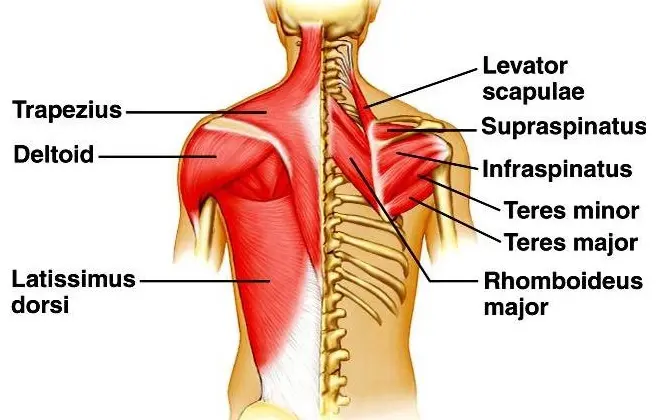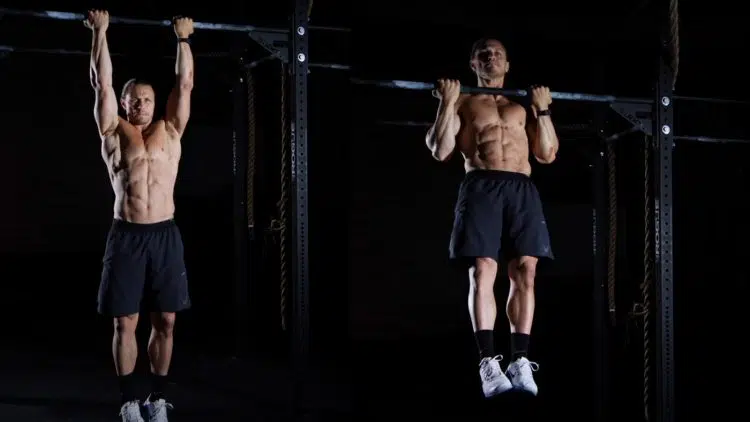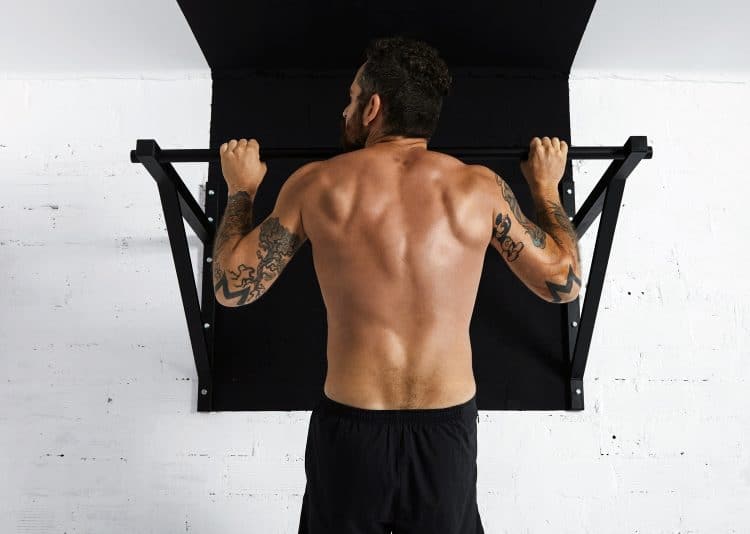Pull-ups and chin-ups are two of the best upper body pulling exercises you can do. Not only will they help you build a broader, stronger back, but they’ll also fill out your sleeves and increase the size of your biceps.
But, on the downside, pull-ups and chin-ups are very demanding. After all, to do either of these awesome exercises, you need to be strong enough to lift your entire body weight using just your arms.
Because of this, a lot of exercisers avoid pull-ups and chin-ups and do lat pulldowns instead.
While lat pulldowns are similar and involve most of the same muscles, pull-ups and chin-ups are vastly superior exercises. For starters, you can do them almost anywhere – including at home if you have a power tower or pull-up bar.
So, whether you have yet to do your first pull-up or chin-up or want to work up to cranking out five, ten, or even 20 consecutive reps, use the strategies in this article to get better at these fantastic exercises.
Pull-up and Chin-up Anatomy 101
Level Up Your Fitness: Join our 💪 strong community in Fitness Volt Newsletter. Get daily inspiration, expert-backed workouts, nutrition tips, the latest in strength sports, and the support you need to reach your goals. Subscribe for free!
Pull-ups and chin-ups are compound exercises. That means they work several muscles and involve movement at two or more joints. Most people do pull-ups and chin-ups to develop their upper back, but there is more to these exercises.
The main muscles involved in pull-ups and chin-ups are:
Latissimus dorsi – known as the lats for short, this is the agonist or prime mover during pull-ups and chin-ups. It’s the reason most people do these exercises. The lats are located on the side of your upper back and, when fully developed, look like muscular wings and give your back its width. Well-developed lats are visible not only from the rear but from the front too.
Biceps brachii and brachialis – while your lats are the prime movers during pull-ups and chin-ups, your biceps brachii and brachialis are also hard at work. These anterior upper arm muscles flex your elbows. The supinated hand position means that chin-ups are a little more biceps-centric than pull-ups. Still, both exercises could help you build bigger, more muscular arms.
Forearm flexors – gripping and holding the bar during pull-ups and chin-ups is an excellent way to test and develop your forearms. If you want a firmer grip or beefier lower arms, pull-ups and chin-ups will undoubtedly help.
Mid and lower trapezius and rhomboids – located across and between your shoulder blades, the mid and lower traps and rhomboids are responsible for pulling your shoulders down and back. This stabilizes your shoulder girdle, providing your lats and arms with a solid base from which to work.
Core – while pull-ups and chin-ups are most assuredly an upper back and biceps exercises, your core is also involved. You’ll need to use the muscles of your midsection to stabilize your lower body and prevent swinging. Weighted pull-ups and chin-ups are especially good for increasing core strength and stability.
Get Better at Pull-Ups and Chin-Ups
Are your pull-up chin-up numbers still in the low single-digits? Do you have to swing and kick your way to doing even a couple of reps? Would you like to know how to do more pull-ups and chin-ups?
These are the strategies that’ll take you from pull-up zero to hero!
0. Master your form
Before we reveal the methods that will make you better at pull-ups and chin-ups, make things easier by ensuring that you know how to do both of these exercises correctly. Poor form wastes energy and could be the difference between success and failure.
Not sure what constitutes good pull-up or chin-up technique? Check out our in-depth guide to doing these exercises correctly and determining which variation is right for you.
1. Lose weight
When it comes to pull-ups and chin-ups, what you weigh is what you lift. If you are a little on the hefty side, losing weight will undoubtedly result in more reps. So while losing weight is invariably a slow process, every pound you drop should make doing pull-ups and chin-ups a little easier.
In the meantime, why not do incline or Australian pull-ups instead of full-pull-ups or chin-ups? With this variation, your feet remain on the ground, so you don’t have to lift your entire body weight. This makes them ideal for heavier exercisers.
Related: The Top 20 Simple Weight Loss Tips
2. Do negative reps
You are stronger eccentrically than you are concentrically. That means you can lower more weight than you can lift. So, even if you can’t do many (or any!) pull-ups and chin-ups, you may still be able to lower yourself down under control. This is called negative training or doing negative reps.
Doing negative reps allows you to do pull-ups and chin-ups even if you aren’t strong enough to pull your chin up to the bar. You can use negative reps to build the strength necessary to eventually progress to full reps.
You can do negative-only reps, or, if you can already do several pull-ups or chin-ups, perform a few negative reps at the end of your regular set to work beyond failure.
How to do it:
- Place a box or step next to your pull-up bar. Stand on your platform and hold the bar with an overhand (pull-up) or underhand (chin-up) grip. Position your chin above the bar and contract your upper body.
- Lift your feet off your platform and then, using only your arms, lower yourself down. Make a conscious effort to control your descent, taking anywhere from three to ten seconds per rep.
- Climb back up, reset your upper body, and repeat.
- Terminate your set when you are no longer able to control your descent.
3. Do band-assisted pull-ups and chin-ups
Band-assisted pull-ups and chin-ups are a great way to make these exercises easier. The band offsets some of your body weight, and the stronger the band, the more assistance you’ll get.
Start with a strong band and then gradually progress to a thinner one as you get stronger until you can do pull-ups and chin-ups unaided.
The best type of bands for assisted pull-ups and chin-ups are fixed loop bands. Resistance bands with handles are not as useful.
How to do it:
- Loop your resistance band over the middle of your pull-up bar and thread it through itself. Let the long end hang down toward the floor.
- Hold the bar with an overhand (pull-up) or underhand (chin-up) grip.
- Kneel or stand in the bottom of your resistance band loop. Extend your arms, pull your shoulders down and back, and brace your abs.
- Bend your arms and pull your chin up and over the bar as the band shortens and provides assistance.
- Lower yourself back down until your arms are straight and repeat.
4. Do pull-up/chin-up ladders
The best way to get better at something is to do more of it. After all, practice makes perfect, right?! But, if you can’t do many pull-ups or chin-ups, how can you do more reps to get better at them?
One answer is ladders.
With ladders, you do one rep, rest a few seconds, and then do two reps, and rest again. This sequence continues until you cannot do any more reps in good form.
Rest a little longer as the reps increase to ensure you can complete as many ladder “rungs” as possible. When you add up all the reps, you should find that you have done several more reps than you would when doing regular reps.
For example, someone who can typically only grind out five or six reps will probably be able to do a 1, 2, 3, 4 rep ladder, which adds up to 10 reps!
So, instead of doing three sets of regular reps, do three ladders. Although you probably won’t be able to do as many reps each time, you’ll still accumulate more reps per workout, which will boost your pull-up/chin-up performance.
5. Grease the groove
Grease the groove is another type of training that allows you to accumulate a lot of reps and improve your pull-up/chin-up performance.
Level Up Your Fitness: Join our 💪 strong community in Fitness Volt Newsletter. Get daily inspiration, expert-backed workouts, nutrition tips, the latest in strength sports, and the support you need to reach your goals. Subscribe for free!
Popularized by Russian strength and kettlebell training expert Pavel Tsatsouline, this method involves doing a high volume of the exercise you want to improve without training to failure.
The idea is to practice perfect form and avoid fatiguing your muscles or nervous system. By avoiding muscular failure, you can do lots of mini-workouts workouts over the course of a day, as it only takes minutes, and not days, to recover from each one. This will allow you to accumulate far more pull-ups or chin-ups than if you did fewer sets to failure.
Not convinced? Think about it like this…
Imagine you are learning to hit a golf ball. During practice, you do so many swings that you get tired, and your form deteriorates so much that you can’t even hit the ball. With this approach, you aren’t going to improve much, if at all. Instead of training for success, you end up training to fail.
But, if you take a swing, rest a few minutes, and then swing again, fatigue is no longer an issue. Each practice shot should be close to perfect, and you won’t learn any bad habits. In short, you’ll make more progress by not trying so hard.
To do grease the groove training, do an easy set of pull-ups or chin-ups roughly every waking hour every day for five out of seven days a week. Do just 50-70% of the maximum number of reps you can do for a single set.
So, for example, if you can do ten reps, only do 5-7 reps per grease the groove set. Remember, the idea is to practice doing pull-ups and chin-ups and not annihilate your muscles.
After a few weeks of greasing the groove, you’ll be astonished at how many more reps you’ll be able to do.
Read more about this powerful training method in our in-depth guide.
6. Beef up your biceps
Pull-ups and chin-ups work your lats and biceps. But, out of these two muscle groups, the biceps are invariably weaker and are the muscles that fail first.
So, unless you increase biceps strength, your arms will always be the weak link that brings your set of pull-ups or chin-ups to a premature end.
A lot of exercisers avoid direct biceps training as they believe their biceps and triceps get enough stimulation from the compound exercises in their workouts. While that’s true to an extent, if you need to strengthen your biceps, the best way to do it is to target them with some biceps-specific exercises.
So, if your biceps are your pull-up or chin-up weak link, make sure you dedicate some additional time and energy to training them.
There is no need to employ complicated training methods. Instead, just do 2-4 sets of a couple of different curl variations, e.g.:
- 4 sets of 8 reps barbell curls
- 3 sets of 10 reps dumbbell curls
- 2 sets of 12 reps cable curls
Training your biceps a couple of times a week will undoubtedly increase your pull-up and chin-up performance.
7. Build basic strength with lat pulldowns
If you’re looking at these training strategies and thinking they’re too demanding for you at the moment, you may need to adjust your aim and focus on building some basic strength with lat pulldowns.
Lat pulldowns work most of the same muscles as pull-ups and chin-ups. The obvious difference is that, with lat pulldowns, you pull the bar down to your chin while, with pull-ups and chin-ups, you pull your chin up to the bar.
Related: Lat Pulldowns vs. Pull-ups
With lat pulldowns, you can change the weight to match your current strength, and your body weight is no longer an issue, either.
However, to develop the strength necessary to progress to doing pull-ups and chin-ups, you need to use reasonably heavy weights for lat pulldowns. For example, sets of 20 reps with light weights won’t prepare your muscles for the demands of doing pull-ups and chin-ups with your body weight.
For even better results, combine lat pulldowns with things like negative pull-ups and band-assisted pull-ups, providing you can do so safely.
Read more about lat pulldowns here.
8. Weighted pull-ups
Most exercisers that do pull-ups and chin-ups eventually plateau and cannot increase their rep count. This is immensely frustrating, especially if you want to work up to, for example, 20 consecutive reps but keep stalling at 15 or so.
One of the best ways to increase your bodyweight rep count is to build strength with weighted pull-ups and chin-ups.
Imagine how much easier these exercises will feel after a few weeks or months of doing pull-ups to chin-ups with 30+ pounds attached to your body.
Weighted pull-ups and chin-ups are significantly more challenging than the unweighted version, so don’t go too heavy too soon.
Instead, start by adding about 10% of your body weight and increasing gradually from there. Keep your reps relatively low, e.g., 5-8 per set, to target the fast-twitch muscle fibers that’ll make you stronger.
After a few weeks of weighted pull-ups or chin-ups, you will be significantly stronger and should find that you can do more unweighted reps as a result.
Wrapping Up
A lot of people find pull-ups and chin-ups difficult, if not impossible. That’s hardly surprising given that you’ve got to lift your entire body weight with just your arms! However, when it comes to building muscle and getting stronger, harder is usually better, which is why it’s worth getting better at pull-ups and chin-ups.
That’s why being able to pump out ten or more strict pull-ups or chin-ups is such a significant fitness achievement.
Sure, some people can do more than ten reps, but there are probably even more exercisers who can’t do anywhere near that many and may not be able to do them at all.
Whether you want to build a bigger back, more muscular biceps, or increase your upper body strength, pull-ups and chin-ups will help. And the better you are at these exercises, the more effective they become.
So, use the eight strategies in this article to boost your pull-up and chin-up performance. Even if you can only do a few reps at the moment, using these techniques means you’ll soon be cranking out pull-ups and chin-ups like a pro!









